Burger King’s Loyalty Program Participants Generate 52% More Revenue than Non-Participating Customers
Burger King’s Loyalty Program Participants Generate 52% More Revenue than Non-Participating Customers
Goals
Increase turnover in digital channels: website, apps, self-service checkout kiosks in restaurants, aggregators
Solutions
Develop a new loyalty program
Develop personalized offers for the loyalty program to minimize the likelihood of guest churn
Consider a bonus point fraud prevention system via the loyalty program’s monitoring toolkit
Develop personalized offers for the loyalty program to minimize the likelihood of guest churn
Consider a bonus point fraud prevention system via the loyalty program’s monitoring toolkit
Results
52% more revenue generated among loyalty program participants compared to non-participants
The new loyalty program was paid off in just 6 months using the new campaigns
The new loyalty program was paid off in just 6 months using the new campaigns
IT stack.
Self-designed website and mobile applications for iOS and Android, self-service checkout kiosks, and R-Keeper POS in restaurants
The following case study is from Mindbox, the original brand behind Maestra’s technology
My name is Arthur Roshchenko, and I’m the Head of Digital Sales at Burger King. I’d like to tell you about how we relaunched our loyalty program, carried out a pilot runthrough, and dealt with negative feedback. I will also be sharing the results we’ve achieved, how the IT infrastructure of the loyalty program works, and which additional mechanics we’ve launched for our loyal customers. Finally, I’ll be sharing some tips for working with direct marketing.
Change in the Loyalty Program’s Mechanics
Since 2018, we have been focusing on digital channels because they account for more than half our sales (i.e., the website, apps, self-service checkout kiosks in restaurants, and aggregators). Additionally, this part of our business is expected to continue growing. That’s why we’ve developed an app-centric loyalty program. The customer accumulates and spends bonus points, participates in competitions and games, and receives special offers all via the app. Previously our guests could spend points anywhere — both at the POS and on the website.
Loyalty program features:
- Guests accumulate points for ordering through different digital channels, i.e., the website, app, self-service checkout kiosks, restaurant POS, and aggregators.
- $1 = 10 bonus “Crowns” points that can only be spent in the app.
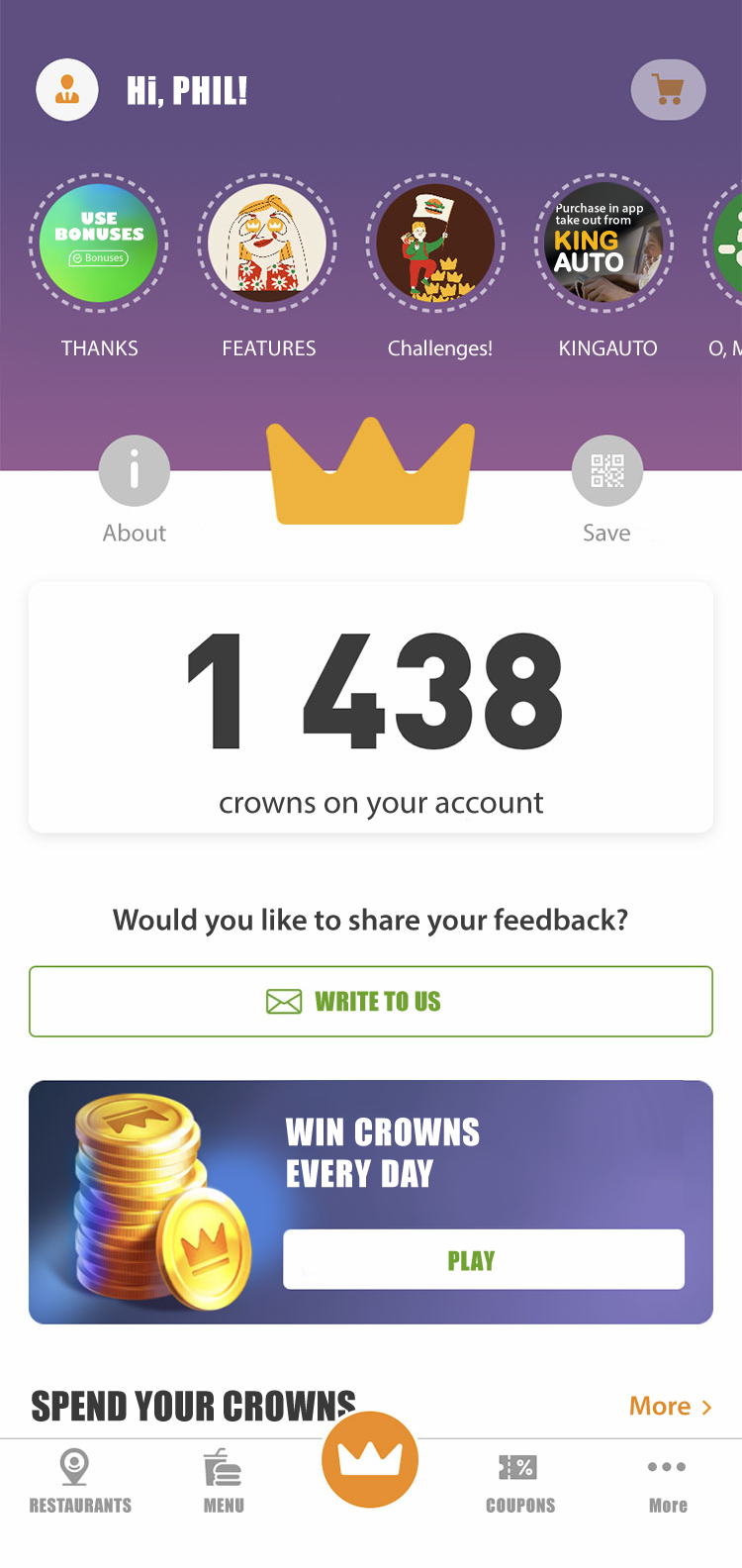
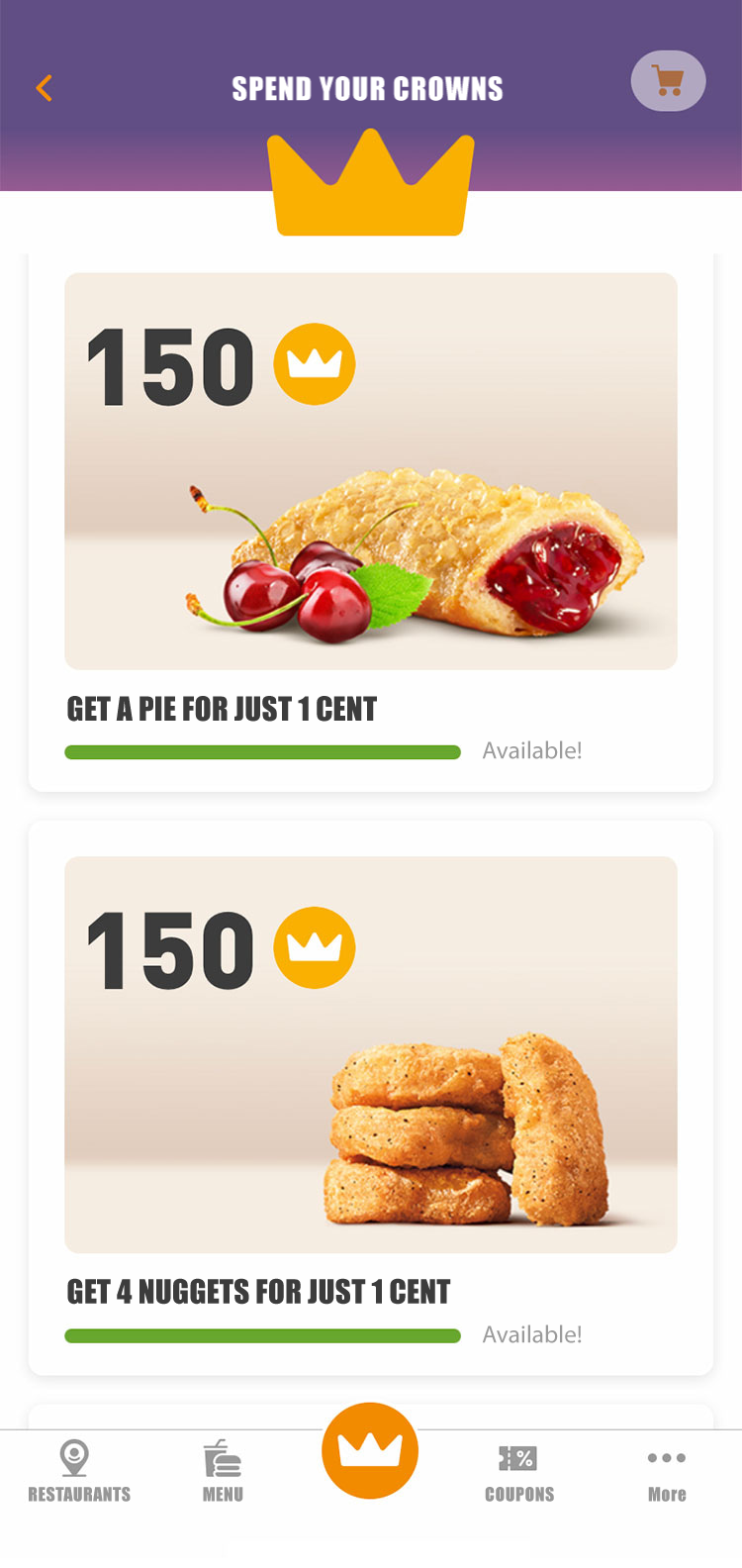
The loyalty program is based on points in the customer’s account and what can be bought for “crowns”
Results of the loyalty program’s relaunch
Indicators of participants in the loyalty program versus non-participants:
-
+52%extra revenue
-
Participants make more frequent purchases -
Participant average order value is higher
We receive additional revenue from loyalty program participants due to their more frequent purchases compared to other guests. The program’s outcome depends entirely on a company’s approach. Some only consider the average order value, while others consider the individual guest. I think it’s essential to track how many times a guest visits the restaurant in a month, in six months and a year. If a company increases its guests over a long period of time, it’ll always find itself in the black.
Our next challenge is to attract guests to the loyalty program who are going to spend more and more with each visit.
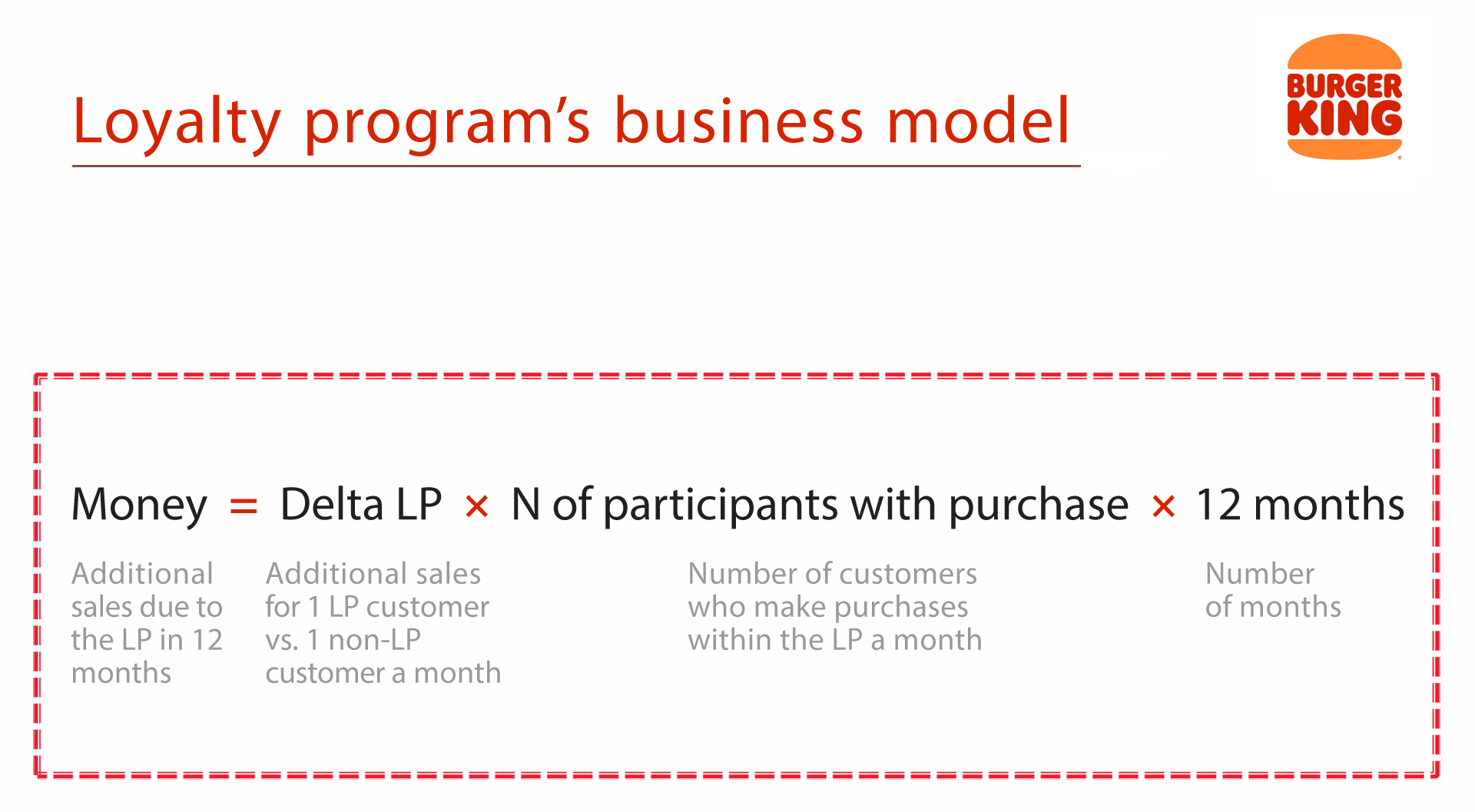
The internal calculation for understanding the business model is based on Burger King’s current data averages. LP = loyalty program and LP participant = loyalty program participant
Additional results from the loyalty program relaunch:
- We paid off the loyalty program in 6 months when we had initially planned to do so in 12.
- We also surpassed our expectations in additional turnover and in the number of guests making purchases through the loyalty program.
We’ve introduced specific KPIs for each month, i.e., a certain number of guests that should be making purchases through the loyalty program. Although our KPIs increase every month, we continue to exceed them. - The amount of online loyalty program purchases is higher than in-person visits in the US and Europe combined. Burger King is a global company. Our managers track sales and compare performance worldwide, while replicating its best practices in other countries for turnover growth. To date, our region’s loyalty program leads the pack out of all of BK’s locations worldwide.
To cut a long story short: It’s worth measuring the efficiency of a public loyalty program via a set of quality data metrics. This includes citing market penetration, comparing customer segments, examining like-for-like indicators, and comparing indicators between regions as part of a test with a control group. However, measuring the public aspect of a loyalty program is not always a requirement. From one aspect, it may be perceived as a tax on customer identification.
Details. It is challenging to measure the efficiency of a public loyalty program. Loyalty program penetration, i.e., the share of orders or revenue that participants generate, is an indisputable metric. Market penetration indicates interest in the program, participant engagement, and our level of knowledge regarding customer behavior. However, this metric does not fully reflect efficiency, so other tools are needed.
For example, Burger King compares the behaviors of loyalty program participants and non-participants. Our team believes that the program encourages repeat purchases and increases the average order amount. Indeed, we have the numbers to reflect this belief when comparing loyalty program participants to non-participants. Not to mention, other major players are doing the same thing. Unfortunately, this metric also has its flaws. It doesn’t show the cause-and-effect relation between whether the loyalty program affects the frequency of sales or whether regular customers have registered for the program.
It’s unquestionably great to be able to look at a set of metrics and see the numbers. Some alternative approaches to measuring performance and its complexity:
— Compare general like-for-like metrics by YOY, MOM, or WOW periods. The challenge is to exclude other factors that affect a change in revenue.
— Compare performance across regions, using one as a control group to launch an entire loyalty program or individual promotions. The challenge, however, is to find comparable regions.
— Assess behavior changes in customers who were in the database prior to the program’s launch (e.g., they gave your online store contact information) and who are now registered as participants. The challenge here is that there may be insufficient data.
— Note: It is not recommended to measure the public side of the program. Think of it as a tax on customer identification and instead measure non-public promotions with control groups. The challenge in this case is to relaunch the loyalty program, but changing its terms and conditions with the public component can significantly impact efficiency.
How We Relaunched Our Loyalty Program: The Pilot Test and Negative Feedback
Changing a loyalty program is a big step. So, to make sure that guests have no trouble understanding and accepting the new rules, we conducted a pilot run of the new program using 10% of our guests as a test group. Because of this pilot run, we managed to detect and fix bugs, correct the loyalty program’s registration campaigns, evaluate how the loyalty program’s changes affected guest relations and determine what kind of profit turnover could be obtained. The pilot launch lasted for one month.
The loyalty program’s launch for all guests didn’t go as smoothly as hoped. We had replaced the old loyalty program’s cashback offer program with an expanded “Crowns” bonus points system. At first, guests who’d had a large amount of cashback in the old program did not understand the way the new one worked. Because of this particular outcome, our ratings on the App Store and Play Market fell. At the same time, the rest of the indicators remained the same.
Our response was that we immediately sent out emails to guests, explaining how many points they would receive in the new loyalty program using the example of their old cashback sum. So, in the end, we managed to reduce negative feedback and re-establish our previous positive ratings in stores. Soon after, our ratings reached a record high.
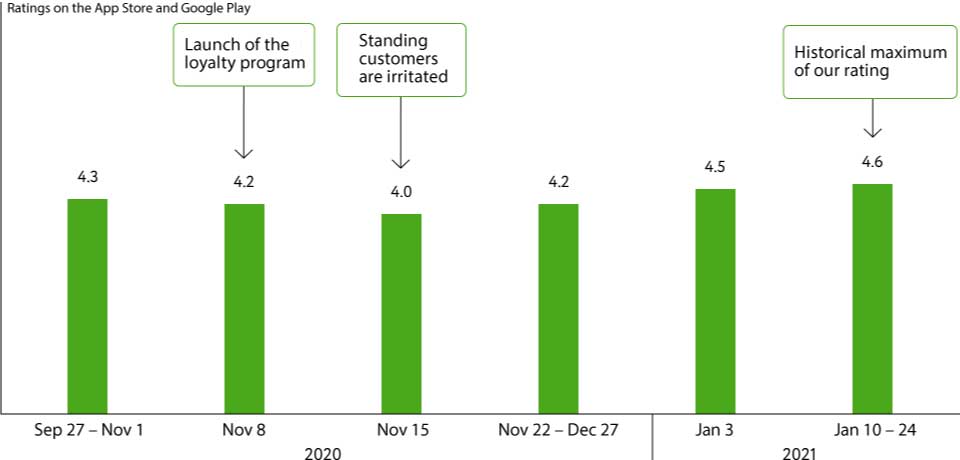
Burger King app rating dynamics on the App Store and Google Play
IT infrastructure of the loyalty program
Mindbox is at the center of our loyalty program’s IT infrastructure. Their platform is interconnected with all our channels:
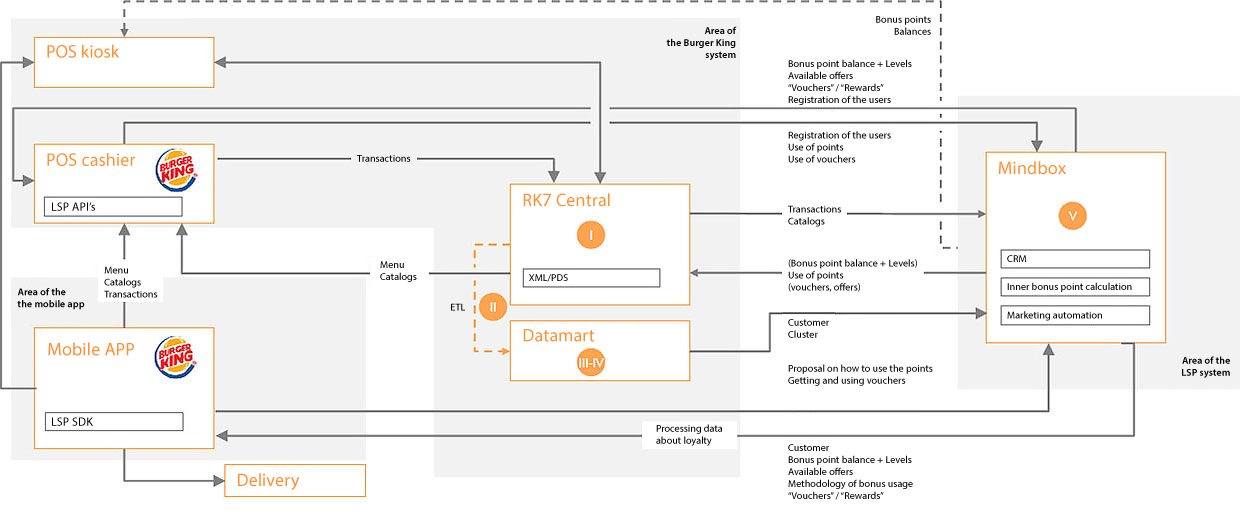
Mindbox within Burger King’s loyalty program IT infrastructure
Additional campaigns being launched
Our main goal now is to increase the frequency of guest purchases. At the same time, it may be that the average order amount could decrease. Right now, the average order value is lower than any other channel on our app. But the guest still spends more, which actually happens due to their frequency of purchases.
To increase the frequency of purchases, we issue:
- Challenges. Challenges like “Buy five chicken burgers and get the sixth free.”
- Personal coupons. Discount offers on customers’ favorite meals.
- Develop new offers for RFM segmentation and guest missions.
- Improve the loyalty program app to make it even more convenient for guests. This will help increase the proportion of guests who purchase through the app. Currently, not all app users are actually making purchases through the app.
- Run game mechanics on the app.


